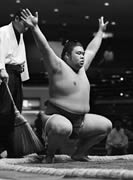
Mark Buckton
Sumo - still Japanese or truly International?
Rikishi of Old
Joe Kuroda
A look at a rikishi of yesteryear with Umegatani II our man for June
Heya Peek
John Gunning
John attends asageiko at Takasago-beya to give us the first of his bimonthly looks at sumo's stables
Photo Bonanza
Kurt Easterwood & Quinlan Faris
Kurt & Quin treat us to some of the best sumo pics around - and seen nowhere else
May Basho Review
Lon Howard & John Gunning
Lon gives us his Natsu Basho summary and his take on upset of the tournament while John chips in with his 'gem' of the basho
Lower Division Rikishi
Mikko Mattila
Mikko provides his round up of the boys in Makushita and below at the Natsu Basho
July Basho Forecast
Pierre Wohlleben & Mark Buckton
Pierre predicts the Nagoya Basho banzuke while Mark previews the ones to watch next time out
Sumo 101
Barbara Ann Klein
Rhyme and reason behind the pre-tachiai rituals that mystified us all as beginners
Kimarite Focus
Mikko Mattila
Mikko walks us through A, B & C
Minusha
John McTague
John's unique view of news from outside the dohyo
Las Vegas Jungyo Teaser
Ngozi Robinson
Months away but like kids at Christmas we are still too excited not to mention it
Online Gaming
Moti Dichne
Hear from the founder of Guess the Banzuke (GTB) on exactly what makes it tick
Le Monde Du Sumo
The original team at MDS tells us how it all started
Sumo Mouse
Todd Lambert
Heya Links Galore and a focus on 3
Fan Debate
JR & EB square off: Right or Left - which should Asashoryu use when receiving kensho?
Let's Hear from You
What was it that made you a sumo fan?
Ngozi Asks
Question of the month - What is Sumo?
Sumo Quiz
The Quizmaster
Answer the Qs and win yourself next basho's banzuke
Sumo 101:
Pre-tachi-ai Rituals
Barbara Ann Klein
for an energy rush. They then proceed to the edge of the dohyo to perform additional symbolic gestures while facing each other. Hands are clapped to summon the gods and palms are turned upwards at the end of outstretched arms to show the absence of weapons before another trip to the ‘corner’ to reload with salt. This time going to the parallel lines at the center of the dohyo, they perform shiko again and crouch in the position they will adopt at tachiai – the face-off.

Returning to the corner and repeating the crouching rituals may be done several times depending upon the ranking of the opponents – the higher the rikishi, the longer the ritual can take. (In the case of the sport’s top rikishi the time allotted is 4 minutes). Finally comes the face-off, at times accompanied by vicious glares, and before you know it - “jikan desu” – it’s time.
Different rikishi tailor make or add to these “standard” movements, some to psyche out their opponents, some to psyche themselves. So, whomever you like, be it Takamisakari, Kitazakura or the yokozuna Asashoryu, watch your own favorite and see the individual idiosyncrasies you perceive in his preparations. In doing so, at least now, you’ll know the reasons and meaning behind their actions.
Photo Credits Home
![]()
Ngozi T. Robinson
Foot-stomping, hand-clapping, one-legged balancing acts; salt throwing and water drinking – what on earth are these gentle giants doing? Can’t they just get into the ring and begin a given day’s bout? While most readers are well acquainted with the rituals engaged in before the actual moment of combat begins, for those of you who may be puzzled by these antics, read on, because I hope to offer some clarification.
Japanese lore attributes the creation and ascendancy of the Japanese nation to the result of a sumo match between rival gods, so the first known sumo matches practiced by humans took the form of rituals celebrating the gods’ presence in their blessed land. Many of the actions now performed before the initial contact of the wrestlers – known as the tachi-ai – continue to have elements of religion.
![]()
When the individual wrestlers, or rikishi, assume the dohyo after being summoned for their bouts, they enter at their respective “corners” and do “shiko”. This is the ritual of driving the demons away, and is performed by raising each leg in turn and slamming the foot into the dirt. Many rikishi have made a fine art of this action, raising their legs to dancers’ split positions before the actual “stomp”. The winning rikishi from the previous bout on the same side as the sumotori now getting ready to fight offers the latter a ladle of chikara mizu, or water of strength. This is generally not swallowed, but is spit back into a black receptacle on the side of the dohyo. Salt, provided in a basket dohyo-side, is tossed onto the dohyo by the rikishi as a symbol of purification. Many rikishi will also dribble some salt on a vulnerable body part – a foot, a shoulder – or even taste the salt
![]()